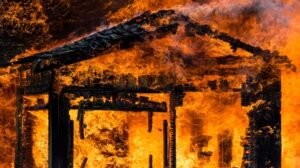If you’ve experienced a house fire and are hesitant about selling a fire-damaged house, understanding the factors influencing your insurance payout is crucial. The cause of the fire and the extent of damage significantly impact the compensation amount. Knowing these details can help you make informed decisions about selling or restoring your property.

One of the biggest factors affecting house fire insurance payments though is whether you have replacement cost coverage or actual cash value coverage.
Actual Cash Value Coverage Versus Replacement Cost Coverage
When choosing insurance, understanding the differences between Actual Cash Value (ACV) Coverage and Replacement Cost Coverage is crucial. Each offers a distinct approach to compensating losses, affecting both the premiums you pay and the payouts you receive. This comparison clarifies each coverage, enabling policyholders to make informed decisions tailored to their needs and finances.
Here is what you need to know about these two types of coverage.
Replacement Cost Coverage
This policy type provides compensation that fully covers the replacement of lost or damaged items at their current market prices. It is favored over actual cash value coverage for effectively restoring homeowners’ pre-fire living conditions.
A replacement cost policy allows the insurance company to pay the policyholder to replace damaged items with new ones at market rates.
Claims under a replacement cost policy may occasionally be paid in two installments.
In the initial installment, the insurer covers the real cash value or a portion of the replacement cost for the replacements.
Then, after receiving proof of the repairs, the insurer covers the remaining expenses in the second installment.
How Replacement Cost Policies Work
The replacement cost coverage option insures homes up to the cost of constructing a comparable structure and personal items up to the cost of buying identical ones. It excludes the land value, as the owner won’t need to repurchase it.
A good idea before you get this type of policy is to hire an appraiser to determine the worth of the covered home and/or personal property.
They can estimate the value of unique or priceless items, such as fine art, entertainment equipment, and jewelry. They also assess the cost of granite, wood, cement, glass, and other materials needed to rebuild a similar house.
Replacement cost policies have a key condition: some insured property items must meet specific requirements to qualify for replacement cost reimbursement. This ensures only eligible items receive full market value compensation.
For instance, some built-in appliances, like a dishwasher or freezer, may have a lifespan that, if exceeded, precludes replacement.
Additionally, the insurance company may decide not to pay for roofing repair expenses if the roof exhibits obvious symptoms of wear and tear. If the repair cost coming out of your own pocket exceeds your property’s value, then selling a fire-damaged house as is could be your best option.
Also, personal items, such as expensive art and crafted artifacts not listed under a scheduled endorsement, may only be covered up to a specific amount.
Actual Cash Value Coverage
The other common type of home insurance coverage is called Actual Cash Value, or ACV.
ACV refers to the market value of a good or a piece of property, or the original worth of a residence once depreciation costs are taken into account.
Home appraisers typically calculate this amount by subtracting the depreciation expense from the item’s or house’s replacement cost.
This policy type offers cheaper rates because it pays out less on claims than replacement cost coverage.
In fact, the cheapest homeowner insurance policy to purchase is one based on real cash value.
This coverage only reimburses you for the item’s worth as it is being sold on the open market. That means the policyholder won’t be able to buy the same item without paying additional out-of-pocket costs.
How Actual Cash Value Policies Work
Actual Cash Value Policies compensate by subtracting depreciation from the item’s original purchase price or current market value. This approach ensures a fair valuation for replaced or repaired items.
If a covered loss occurs, policyholders receive depreciated payments for items like electronics and furniture.
Depreciation cost is figured based on the expected asset lifetime less the percentage of value lost each year since the asset was purchased.
The Bottom Line Between Actual Cash Value & Replacement Cost Policies
Covered events can yield lower real cash value payouts than those from a replacement cost policy.
That’s because the depreciation expenses from wear and tear are factored into the real cash value payout.
The tradeoff for these lower settlement claims is that you pay less in monthly premiums for this type of policy. If you’re cash-strapped and seeking the lowest possible premiums, this policy type may suit you.
The low payouts are a tradeoff for the low premiums.
On the other hand, a replacement cost policy lets the policyholder start over. It covers rebuilding the house with today’s labor and material costs.
The policyholder receives payment for any personal property lost or damaged due to the insured loss. Covered items are replaced with equivalent goods at the current local market rate.
This type of policy also protects against rises in material and labor costs as time passes. But in exchange for those bigger potential payouts, this type of policy requires higher premium payments.
Sell Your Fire-Damaged House
If you recently suffered a house fire and don’t want to go through a long, stressful repair process, you can sell your house as-is to We Buy Fire Damaged Houses.
We pay all cash so that you can get your money fast, combine it with your insurance settlement, and buy an even better house than before this ordeal occurred.
Fill out the form below to learn more.
Photo by Dave Hoefler on Unsplash
Previous